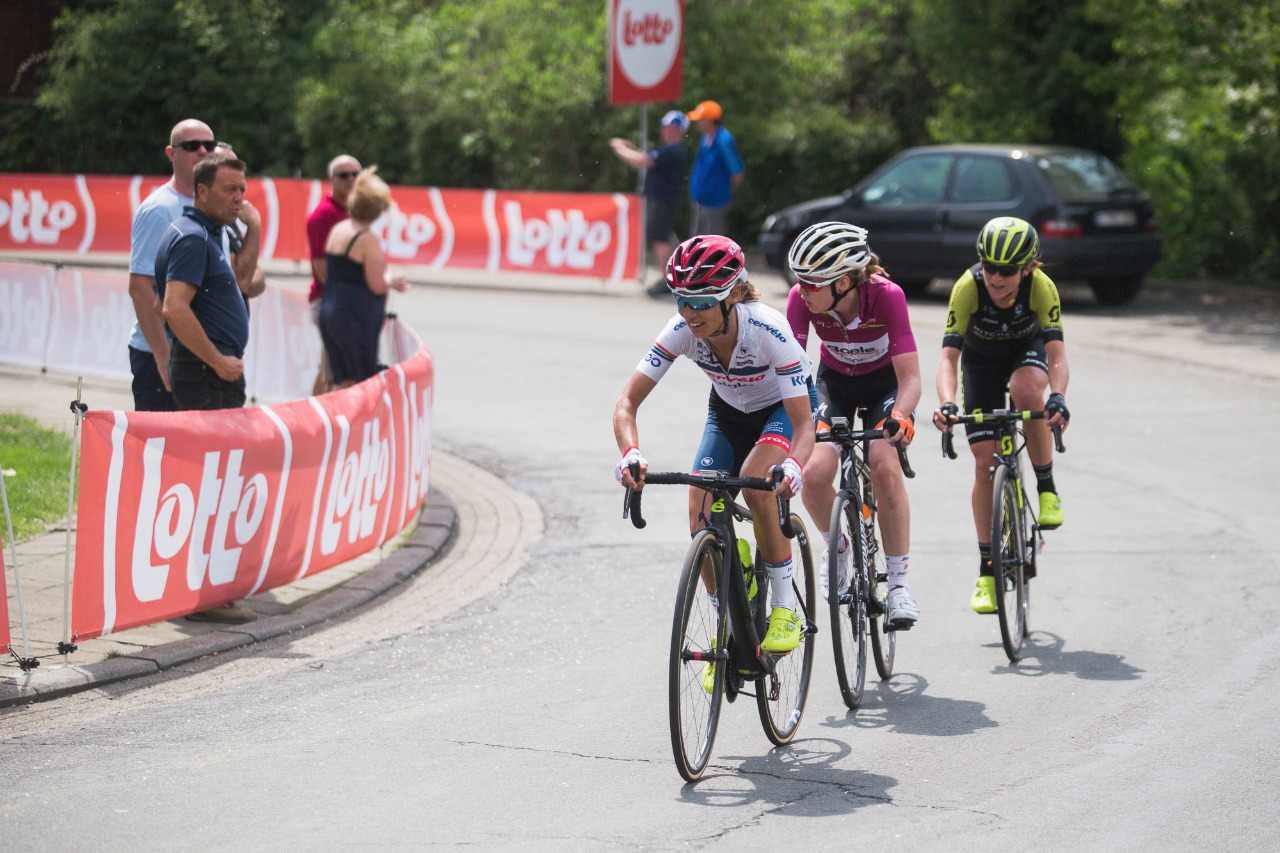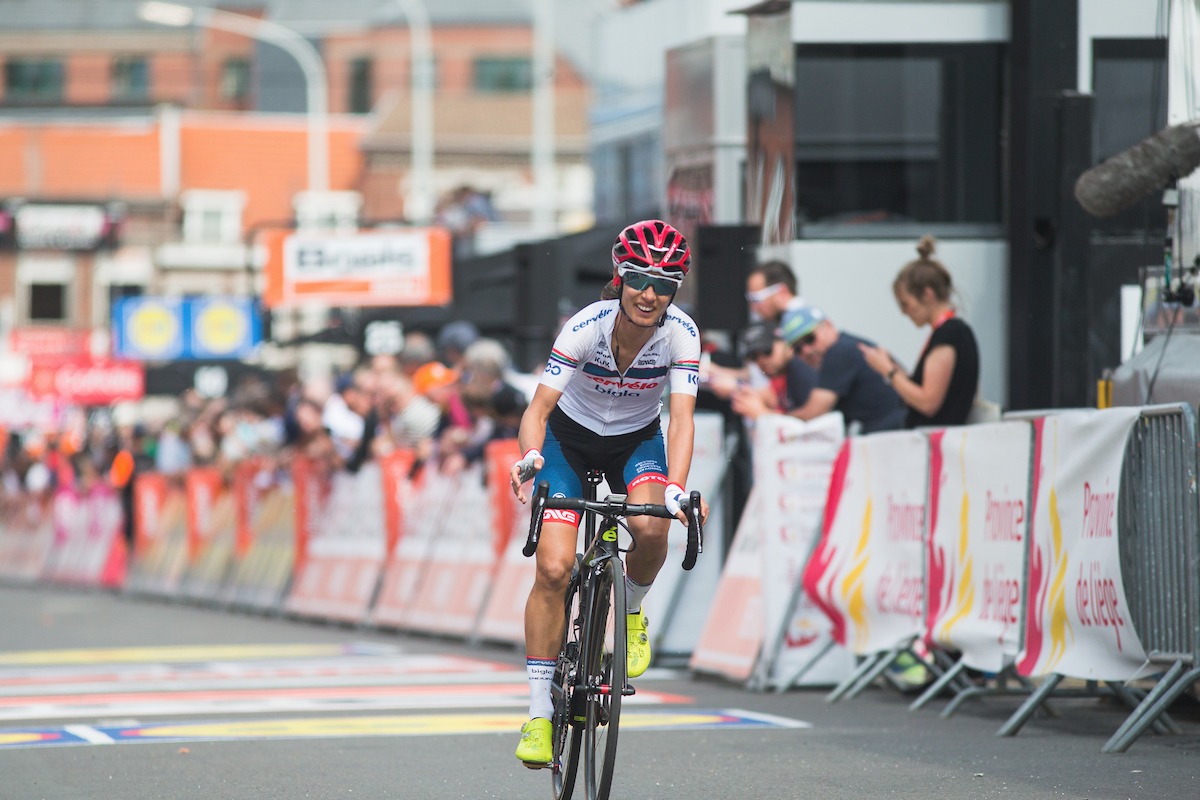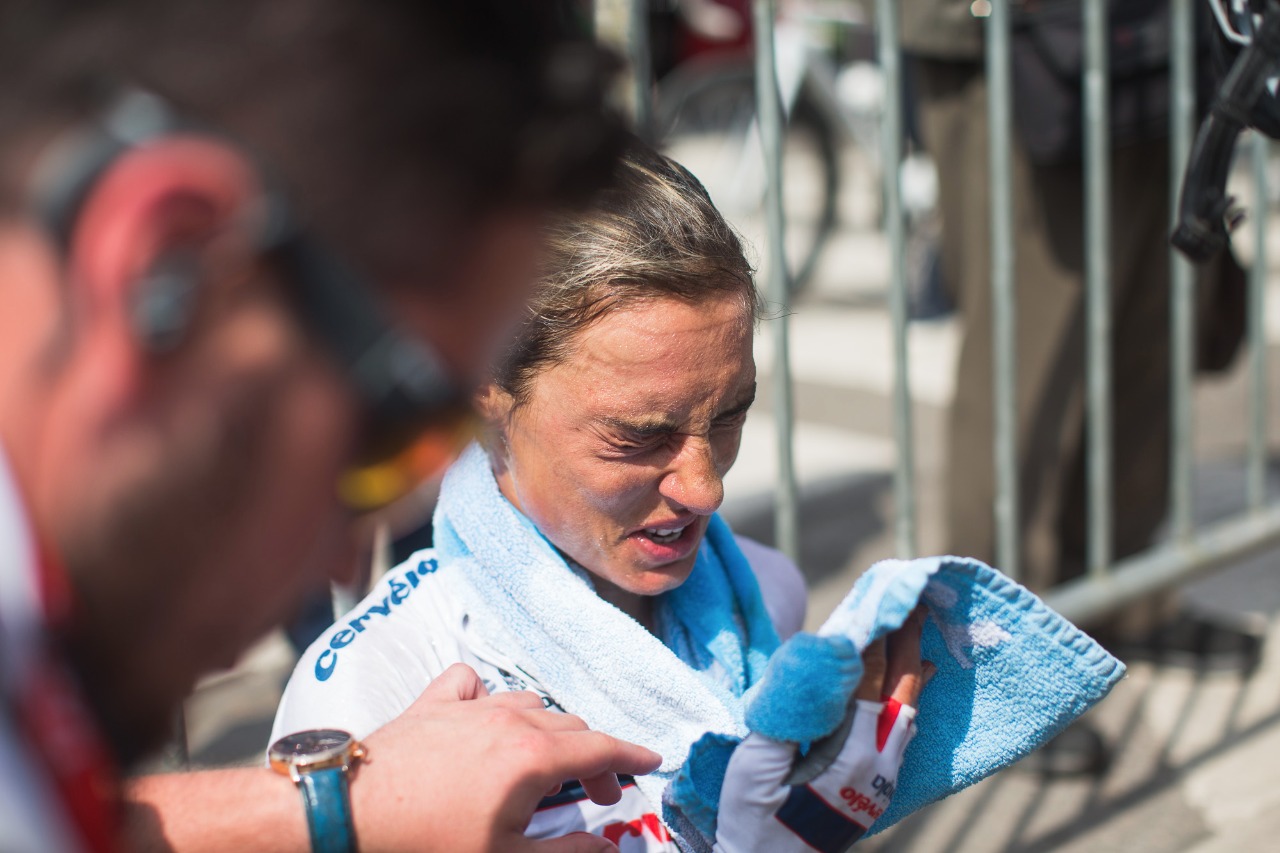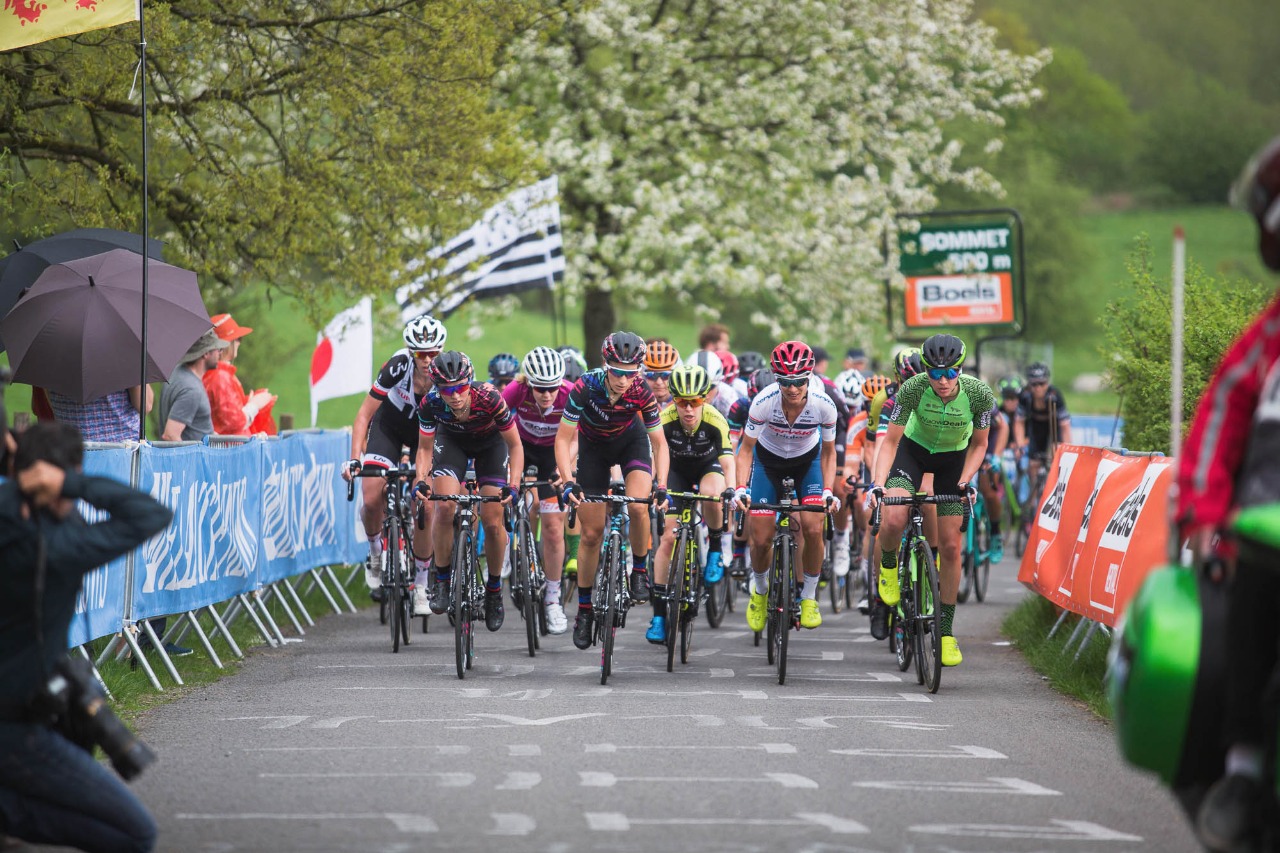The Sting Of Bad Luck
Flanders is one of those races where it still means something if you finish. The tiniest country roads, the unforgiving rough and stupidly steep cobbles, the blood sport fight to position yourself before the climbs, and don’t forget the weather if Mother Nature decides to show up. Actually, it’s one of those races where it still means something if you start and CCC-Liv started perfectly.
No doubt it was the best race we had done as a team. For the first 115 kilometres we had this amazing rhythm, operating like a well-oiled machine and then some. We were riding together, positioned well, Marianne felt amazing and so did I. To have everyone come together like that, it was just another level. We had the goods to pull off a win, we just needed the luck.
The final 30 kilometres is where the big bets are made. I knew we had the fire power to execute the final strategy but as we got together on the Kanarieberg (climb #6) someone switched my wheel. Somehow I didn’t crash and, after a quick foot down, I started to chase back. I wasn’t too far behind but there also wasn’t a lot of time before the next climb, the cobbled Taaienberg (climb #7), where the pressure would continue.
I didn’t have a choice: I had to go all in to catch the peloton or it was race over. I didn’t even have to think about making a decision, my legs were already powering across the gap and up the Kanarieberg.
Image: Jojo Harper
Now, I know Belgian roads. I’ve raced in Belgium for many years. I know the cobbles, the narrow roads, the road furniture, and the wide crack right down the centre of their concrete roads. I’m always aware of that crack. I know it’s there but as if two hands reached up and grabbed my wheels, out of nowhere my bike instantly came to a complete stop. My wheels were both perfectly stuck in that centre crack. Like walking into a glass door, it caught me so off guard I only realized what had happened after I hit the ground, slid across the road into the ditch, and came to a stop in stinging nettles.
Grazed and confused, I got up and back to my bike. The drivetrain was all messed up. I definitely needed a new bike but, after the big splits on the Kanarieberg, the team cars were too far behind. Everything had happened so fast that I could actually still see the bunch ahead. It didn’t matter what I had, I needed to go all in again if I was to get back.
Image: Oliver Grenaa
My body was stinging all over from nettles and road rash but my muscles were working. I got back up to speed and as I clicked into an easier gear as I hit the bottom of the Taaienberg, my derailleur went into my back wheel and fell off! “Ok, that’s it,” I thought with a sigh. With the odds so stacked against me, it was smarter to save my legs for the next race.
Up at the front Marriane wasn’t faring much better with a poorly timed puncture. I couldn’t help but feel disappointed; it really wasn’t our day. You can have the best legs and the best team on the day but to win a bike race you always need some luck or, at least, no bad luck. Still, we had finished one of the toughest Spring Classics and the magic of the first 115 kilometres made me believe at the next race our luck would change.
Discover more about Ashleigh’s home Rocacorba Cycling
Rocacorba Gravel Gran Fondo
Everyone has a different idea of gravel, that’s what’s so exciting. As a more niche sport, there aren’t any hard or fast rules about what a gravel Gran Fondo should be. When we started to plan the course in collaboration with the Rocacorba Gran Fondo organization, we all had a different idea of what should be included. In the end, we settled on the idea of celebrating the Rocacorba mountain in a new way with an unforgettable adventure.
Under the stone arch of the courtyard, the inaugural sold out ride took off from Can Campolier for the 57km route. Before hitting the climbs, the route took in the sights of Banyoles lake and then a small river crossing. Some took tyres through the ankle-deep water, others hopped across the stones.
The name “Rocacorba” always signifies a challenge so, of course, the riders tackled the slopes of our namesake climb. Up and down on the lower half of the mountain gave the riders a chance to take on steep climbs, fast descents, slow descents, loose gravel, rolling dirt, and road. The mixed terrain naturally separated riders into smaller groups and, while some were pushing the pace and others were more relaxed, everyone finished.
Greeted by a cold Rocacorba craft beer afterwards, everyone sprawled out on the lawn to enjoy the sunshine and hearing everyone’s stories, we knew we had success on our hands. From the seasoned gravel riders who travelled to join us to those who took on their first gravel experience, people had come back with memorable stories. Not only had we showcased Rocacorba in a new and different way but we really had created an unforgettable day of adventure.
Join our Girona Tour from the 24th - 30th May and kick off your stay with the Rocacorba Road Gran Fondo on May 25th.
Setmana Ciclista Valenciana
Off the back of a fantastic 10 day training camp at Rocacorba Cycling, it was finally time to get on a start line again. Our European opener was the four stage Setmana Ciclista Valenciana, just down the coast from Girona and it really did feel like an early season race.
The bunch was basically a bundle of nerves. A winter’s worth of race anticipation unleashed a series of crashes that claimed many riders. Fortunately, the whole team managed to stay upright and out of trouble and, by the third stage, we we well positioned to put our attack plan into motion.
Stage Three was the queen stage and the obvious crux that would decide the general classification was Xorret de Catí. I had looked at the parcours but it wasn’t until we reconned the climb a few days before the race that I realised how completely savage it was. A part of the Vuelta Espana many times in the past, the 4km climb has an average gradient of 11% with much steeper sections, especially during the second half the climb. Nothing could have prepared me for what I saw; the last 2km were savage! I like steep climbs more than most but this early in the season, I felt a little underprepared!
The stage was completely predictable but it wasn’t lacking in fireworks. A break had gone after the longer climb leading up the Xorret de Catí, with one of the riders, Soraya Paladin, having some valuable GC time. It wasn’t ideal but, as a team, we decided to stick to the plan, let the break go, and save it for the big beast of a climb that lay ahead. We hit the bottom and Movistar took control and set a demanding pace. Attacks started, including one from us, and chasers ramped up the pace again. I sat in and eventually we were down to a few riders and the fight was on.
The road was decorated with names and there were sections lined with encouraging spectators but not for one second did I forget about me legs when the road tilted up and over 15%, 20%, and more. We caught what was left of the break but Clara Koppenburg stayed out of the saddle and mashed her way past the break and to the front of the race. It took me a bit longer to work my way past the break and by the time I had, Clara had a spacious gap. By the summit, Clara was clearly on her way to victory and I was coming in for second.
Although I finished ahead of Paladin, her time advantage from the previous stage wasn’t to be overcome on the next day and neither was the 49 seconds that Koppenburg had claimed on the Catí. As the fourth and final stage ended with a bunch sprint, the GC unchanged, third was a great way to both finish our training camp and start our European season. Onwards and orange ;)
Only The Best
Riding somewhere new can be great. It can also be terrible. There is nothing worse than showing up to ride a route or climb you have dreamed about only to end up on the busiest roads, going the wrong way, at the worst time. We’ve all been there. A lot of people come to Girona and waste precious kilometres when they could be riding the good stuff.
I never realized the value of a guide until I became one. After riding in Girona for many years, it’s second nature for me to put together routes. From the Costa Brava to the Pyrenees and every back-lane, not-on-Google-Maps road, I’ve ridden it. There are certain things that you just have to find out and experience first-hand on two wheels. Of course I know all the climbs, how to fix any road-side mechanical, and the best places to stop for coffee but it’s more than that. Its creating rides even the seasoned Girona rider would be excited by, knowing where the water taps are on abandoned back roads, the most picturesque places to stop for photos, where all the friendly donkeys are, and, of course, the inevitable conversations along the way.
I’ve ridden with dentists, accountants, geologists, stay-at-home parents, lawyers, photographers. . . from all around the world. After a long ride it’s hard to remember I’m a guide because after the ride we’re all just tired, happy, and ready for a piece of chocolate cake or (and, in some cases) a beer. I can get you from A to B on the best and most incredibly quiet roads you’ve ever ridden but you’ll find out the really good stuff is along the way.
Beat the Odds
Anyway you slice it, four against six made us the underdog. Festival Elsy Jacobs is a an annual favourite of mine (especially because there is fantastic online live coverage) but showing up with only four riders against the big teams of six meant it was going to feel like a new race.
Cille had made the podium in the prologue but, after being caught behind a crash, we all walked away from the second day disappointed. We were also down to just three riders going into the final stage thanks to a sore throat. It seemed like the odds were just too stacked against us but it’s not always a numbers game.
I broke away. It was my second break of the day and there were 40km left so I set more conservative tempo, hoping to attract some company. Race leader Christine Majerus and Alexis Ryan of Canyon-SRAM joined me which eventually enticed a large group across. As we merged, it was obvious everyone was waiting for the final hills to attack. Not me.
I caught everyone off guard. It wasn’t the textbook place to make a move but it was the perfect moment. I got away solo with only 20km of road until the finish and the chase was on. I drove it hard, feeding off the energy of having the biggest teams in the peloton hunt me down. I found out later Majerus was really feeling the pressure while Lotta played it perfectly cool.
Of course, sometimes it is a numbers game. Eventually I was caught but, even without a lead out, Lotta sprinted into second place. We might not have won but Cervelo Bigla definitely beat the odds.
Race big
We showed up at Liège-Bastogne-Liège ready to go big. After our 2nd place at La Flèche Wallonne, we were on a high and everyone wanted to push a little farther, swing a bit bigger. But Liège is not Flèche.
Flèche always, always, always comes down to a few riders on the Mur, but Liège is a race that can be won by different types of riders and different types of strategies. The sprinters can make it over the climbs, a break could win…the possibilities come down to who is willing to make the race and we wanted to be those riders.
Being aggressive isn’t just one moment of attack. Before that moment there is an orchestrated sequence of events carried out by different members of the team. Emma Norsgaard our 18 year old last minute substitution, had to get over La Vecquee and help me on the descent; Ann-Sophie Duyck buried herself to survive long enough to place me leading into the La Roche; Cecilie Uttrup Ludwig had to lead me out into Saint-Nicolas. As we approached Côte de La Roche, everyone had done their part so it was my turn to execute.
We hit the bottom of the climb and I attacked. The big players followed. The same three riders I was with in the final hundred meters of Flèche were on my wheel: Anna van de Breggen, Annemiek Van Vleuten, and Megan Guarnier A group joined us from behind and, after two moves were neutralized, Amanda Spratt got away solo.
On the penultimate climb, it was time to swing again. We hit the bottom and I attacked. Anna and Annemiek followed. I pushed the pace but at the top Anna counter-attacked, eventually bridging across to Amanda. I was left with Annemiek glued to my wheel.
I could see Anna and Amanda up the road but I knew Annemiek was not going to help me chase her teammate down. I also knew there was a group chasing us from behind. My brain ran queries, trying to figure out the best move. The odds were, let’s just say, unfavourable but I owed it to the team to try. I knew it was going to take some miracle to finish third but maybe we would rejoin? Maybe I had enough to hold off the chasing bunch behind us and finish at least fourth. We hadn’t shown up to race Liege conservatively.
I put my head down and went for it. I could almost feel the weight of Annemiek in my legs as I towed her to the line. Naturally, she attacked and out-sprinted me but I had managed to hold off the chase pack and finish in fourth.
Of course we wanted to win, to get a podium, but when the ride from start to finish is that exciting, when your team spirit is unmatched in the pro peloton, when you race that big, you definitely have no regrets.





























